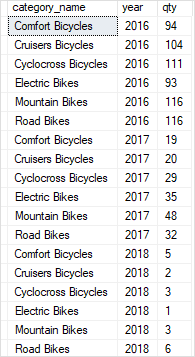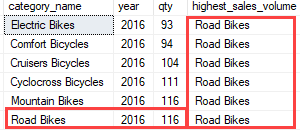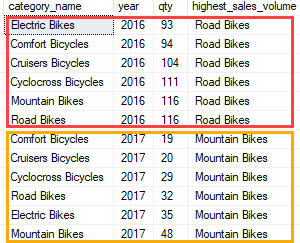Summary: in this tutorial, you will learn how to use the SQL Server LAST_VALUE() function to get the last value in an ordered partition of a result set.
SQL Server LAST_VALUE() function overview
The LAST_VALUE() function is a window function that returns the last value in an ordered partition of a result set.
The following shows the syntax of the LAST_VALUE() function:
LAST_VALUE ( scalar_expression )
OVER (
[PARTITION BY partition_expression, ... ]
ORDER BY sort_expression [ASC | DESC], ...
) Code language: SQL (Structured Query Language) (sql)In this syntax:
scalar_expression
scalar_expression is an expression evaluated against the value of the last row in an ordered partition of the result set. The scalar_expression can be a column, subquery, or expression evaluates to a single value. It cannot be a window function.
PARTITION BY clause
The PARTITION BY clause distributes rows of the result set into partitions to which the LAST_VALUE() function is applied. If you skip the PARTITION BY clause, the LAST_VALUE() function will treat the whole result set as a single partition.
ORDER BY clause
The ORDER BY clause specifies the logical order of the rows in each partition to which the LAST_VALUE()function is applied.
rows_range_clause
The rows_range_clause further limits the rows within a partition by defining start and end points.
SQL Server LAST_VALUE() function examples
We will use the sales.vw_category_sales_volume view created in the FIRST_VALUE() function tutorial to demonstrate how the LAST_VALUE()function works.
The following query returns data from the view:
SELECT
category_name,
year,
qty
FROM
sales.vw_category_sales_volume
ORDER BY
year,
category_name,
qty;
Code language: SQL (Structured Query Language) (sql)
A) Using LAST_VALUE() over a result set example
This example uses LAST_VALUE() function to return category name with the highest sales volume in 2016:
SELECT
category_name,
year,
qty,
LAST_VALUE(category_name) OVER(
ORDER BY qty
RANGE BETWEEN
UNBOUNDED PRECEDING AND
UNBOUNDED FOLLOWING
) highest_sales_volume
FROM
sales.vw_category_sales_volume
WHERE
year = 2016;
Code language: SQL (Structured Query Language) (sql)Here is the output:

In this example:
- The
PARTITION BYclause was not specified therefore the whole result set was treated as a single partition. - The
ORDER BYclause sorted rows in eachpartition byquantity (qty) from low to high. - The
RANGE BETWEEN UNBOUNDED PRECEDING AND UNBOUNDED FOLLOWINGclause defined the frame in the partition starting from the first row and ending at the last row.
B) Using LAST_VALUE() over partitions example
The following example uses the LAST_VALUE() function to return product categories with the highest sales volumes in 2016 and 2017.
SELECT
category_name,
year,
qty,
LAST_VALUE(category_name) OVER(
PARTITION BY year
ORDER BY qty
RANGE BETWEEN
UNBOUNDED PRECEDING AND
UNBOUNDED FOLLOWING
) highest_sales_volume
FROM
sales.vw_category_sales_volume
WHERE
year IN (2016,2017);
Code language: SQL (Structured Query Language) (sql)The following picture shows the output:

In this example:
- The
PARTITION BYclause distributed rows by year into two partitions, one for 2016 and the other for 2017. - The
ORDER BYclause sorted rows in eachpartition byquantity (qty) from low to high. - The
RANGE BETWEEN UNBOUNDED PRECEDING AND UNBOUNDED FOLLOWINGclause defines the frame starting from the first row and ending at the last row of the partition. - The
LAST_VALUE()function was applied to each partition separately. For the first partition, it returnedElectric Bikesand for the second partition it returnedComfort Bicyclesbecause these categories were the last rows in each partition.
In this tutorial, you have learned how to use the SQL Server LAST_VALUE() function to return the last value in an ordered partition of a result set.